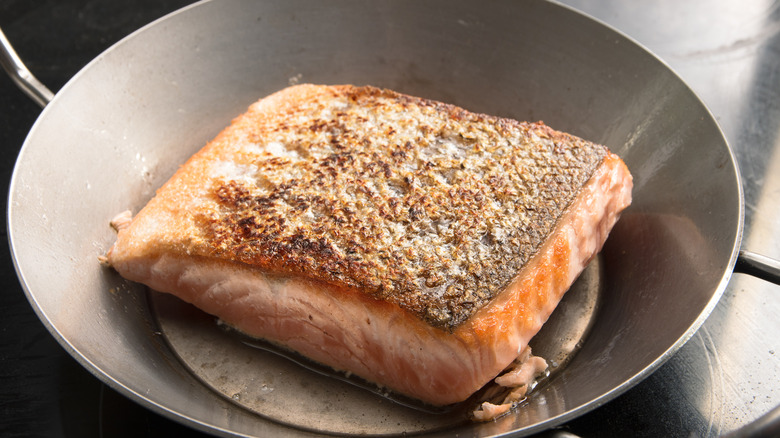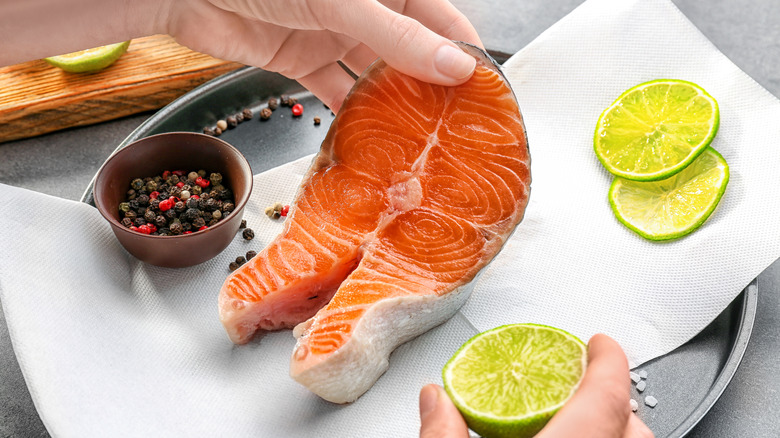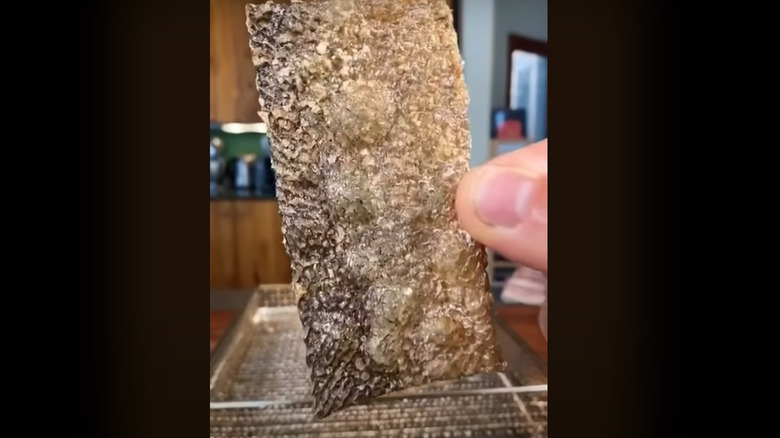Achieving The Crispiest Salmon Skin In The Oven Requires Precision
Sure, the perfect salmon filet is moist and tender, with a delicate flakiness that melts in the mouth. But the most satisfying part for some is the crispy skin. We're talking bacon crisp, to the point where it crackles, giving way to the succulent, buttery richness of the salmon beneath.
There are a dozen ways to prepare salmon, whether pan-fried, grilled, roasted, baked in foil, air-fried, or some other method. However, achieving the crispiest salmon skin in the oven requires careful precision. Low and slow won't give you the crunch you're after, and a too-hot oven will quickly result in an overcooked fish.
To achieve the crispiest salmon skin in the oven, it's all about the broiler, coupled with the perfect rack placement. Using the broiler as the heating element helps crisp the skin nicely while cooking the inside of the salmon to the ideal texture. It only takes about seven to 10 minutes if you follow the 10-minute rule, which calls for cooking fish 10 minutes for every inch of thickness. But the real trick to crispy skin is the rack placement inside the oven. For optimal results without burning the filet, it's crucial to position the oven rack precisely in the upper-middle spot, which is probably a couple of notches from the top, depending on the oven. Remember to place the salmon skin-side up.
It's all in the preparation
Another key to perfectly crisp your salmon skin is to make sure the filet is thoroughly dried before cooking. Excess moisture on the skin can hinder the crisping process, resulting in a mushy texture. Be sure to pat the salmon dry with paper towels before popping it in the oven. This will also create an ideal surface for seasoning. Removing the moisture ahead of cooking also prevents the salmon from steaming rather than roasting in the oven.
If you are working with frozen salmon filets and still want to achieve that crispy exterior, thaw them fully first and make sure there are no remaining ice crystals. Once the filet is patted dry, refrigerate it skin-side up for up to an hour. The refrigerator's low humidity level will effectively air-dry the fish even more.
Or give dry-brining a try. This method involves salting your salmon filet with a teaspoon of kosher salt, placing it on a paper towel-lined sheet, and refrigerating overnight without a cover. Chef and food journalist J. Kenji López-Alt explained how the process helps reduce the water content in a New York Times how-to. He said, "With the dry-brined filets, most of this moisture evaporates during storage; only a small amount comes out during cooking. With fresh, on the other hand, all that moisture is pushed into the pan during cooking, where it must then evaporate."
Speaking of bacon...
We want our salmon skin to crisp up like bacon, yes. But you can actually make healthy faux "bacon" with it, too. There are a few methods at your disposal to prepare this bacon-of-the-sea treat. First, separate the skin from either the cooked or the raw salmon filet and use a knife to scrape away any scales, remaining filet, or residue. Season the skin as desired. Then, choose your cooking method: Bake on a sheet in the oven, pan fry in some butter or oil, or air fry to crispy perfection.
Salmon skin bacon is a great way to enjoy all the benefits of salmon skin without having to consume it in its original scaly form. We all know that salmon is rich in protein, omega-3 fatty acids, and antioxidants. But did you know that the bulk of the omega-3 in salmon is in the skin itself? That's another tick in the plus column for enjoying oven-cooked crispy salmon skin.


